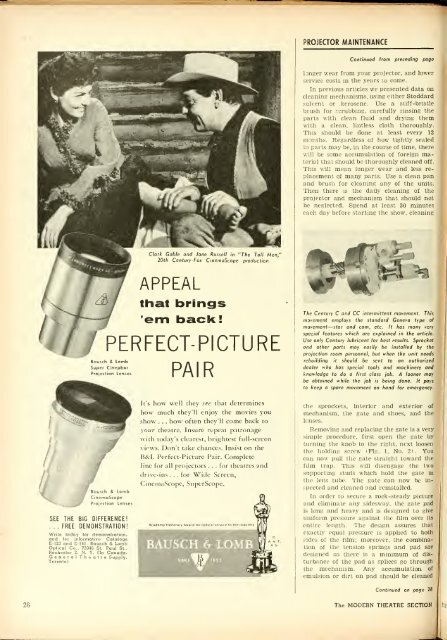Boxoffice-October.01.1955
Create successful ePaper yourself
Turn your PDF publications into a flip-book with our unique Google optimized e-Paper software.
PROJECTOR MAINTENANCE<br />
Continuerf irom preceding page<br />
longer wear from your projector, and lower<br />
service cost.s in the years to come.<br />
In previous articles we presented data on<br />
cleaning mechanisms, using either Stoddard<br />
solvent or Icerosene. Use a stiff-bristle<br />
brush for scrubbing, carefully rinsing the<br />
parts with clean fluid and drying them<br />
with a clean, lintless cloth thoroughly.<br />
This should be done at least every 12<br />
months. Regardless of how tightly sealed<br />
in parts may be, in the course of time, there<br />
will be some accumulation of foreign material<br />
that should be thoroughly cleaned off.<br />
This will mean longer wear and less replacement<br />
of many parts. Use a clean pan<br />
and brush for cleaning any of the units.<br />
Then there is the daily cleaning of the<br />
projector and mechanism that should not<br />
be neglected. Spend at least 30 minute.s<br />
each day before starting the show, cleaning<br />
that brings<br />
'em back!<br />
/PERFECT-PICTURE<br />
Bausch & Lomb<br />
Super Cinephor<br />
Proiection Lenses<br />
PAIR<br />
^~«l.<br />
The Century C and CC intermittent movement. This<br />
movement employs the standard Geneva type of<br />
movement— star and cam, etc. It has many very<br />
special features which are explained in the article.<br />
Use only Century lubricant for best results. Sprocket<br />
and other parts may easily be installed by the<br />
projection room personnel, but when the unit needs<br />
rebuilding it should be sent to an authorized<br />
dealer who has special tools and machinery and<br />
knowledge to do a first class job. A loaner may<br />
be obtained while the job is being done. It pays<br />
to keep a spare movement on hand for emergency.<br />
SEE THE BIG DIFFERENCE!<br />
. . . FREE DEMONSTRATION!<br />
Writo today for domonHtralion.<br />
and lor iniormalivo Catalogs<br />
E-123 and £141. Bausch d Lomb<br />
Optical Co., 72046 St. Paul St.,<br />
RoehoBtsr 2. N. Y. (In Canada.<br />
Gonoral Theaira Supply,<br />
Toronto)<br />
It's how well they sec that determines<br />
how much they'll enjoy the movies you<br />
show . . . how often they'll come back to<br />
your theatre. Insure repeat patronage<br />
with today's clearest, brightest full-screen<br />
\ ifws. Don't take chances. Insist on the<br />
B&L Perfect-Picture Pair. Complete<br />
line for all projectors . . . for theatres and<br />
drive-ins . . . for Wide Screen,<br />
CinemaScope, SuperScope.<br />
the sprockets, interior and exterior of<br />
mechanism, the gate and shoes, and the<br />
lenses.<br />
Removing and replacing the gate is a very<br />
simple procedure, first open the gate by<br />
turning the knob to the right, next loosenj<br />
the holding screw (Fig. 1, No. 2). Youl<br />
can now pull the gate straight toward the<br />
film trap. This will disengage the two<br />
supporting studs which hold the gate in<br />
the lens tube. The gate can now be in- j<br />
'<<br />
spected and cleaned and reinstalled.<br />
In order to secure a rock-steady picture<br />
and eliminate any sidesway. the gate pad<br />
is long and heavy and is designed to give<br />
uniform pressure against the film over its<br />
entire length. The design assures that<br />
exactly equal pressure is applied to both<br />
sides of the film; moreover, the combination<br />
of the tension springs and pad are<br />
designed so there is a minimum of disturbance<br />
of the pad as splices go through<br />
the mechanism. Any accumulation of<br />
emulsion or dirt on pad should be cleaned<br />
Continued on page 2S<br />
26<br />
The MODERN THEATRE SECnON

















